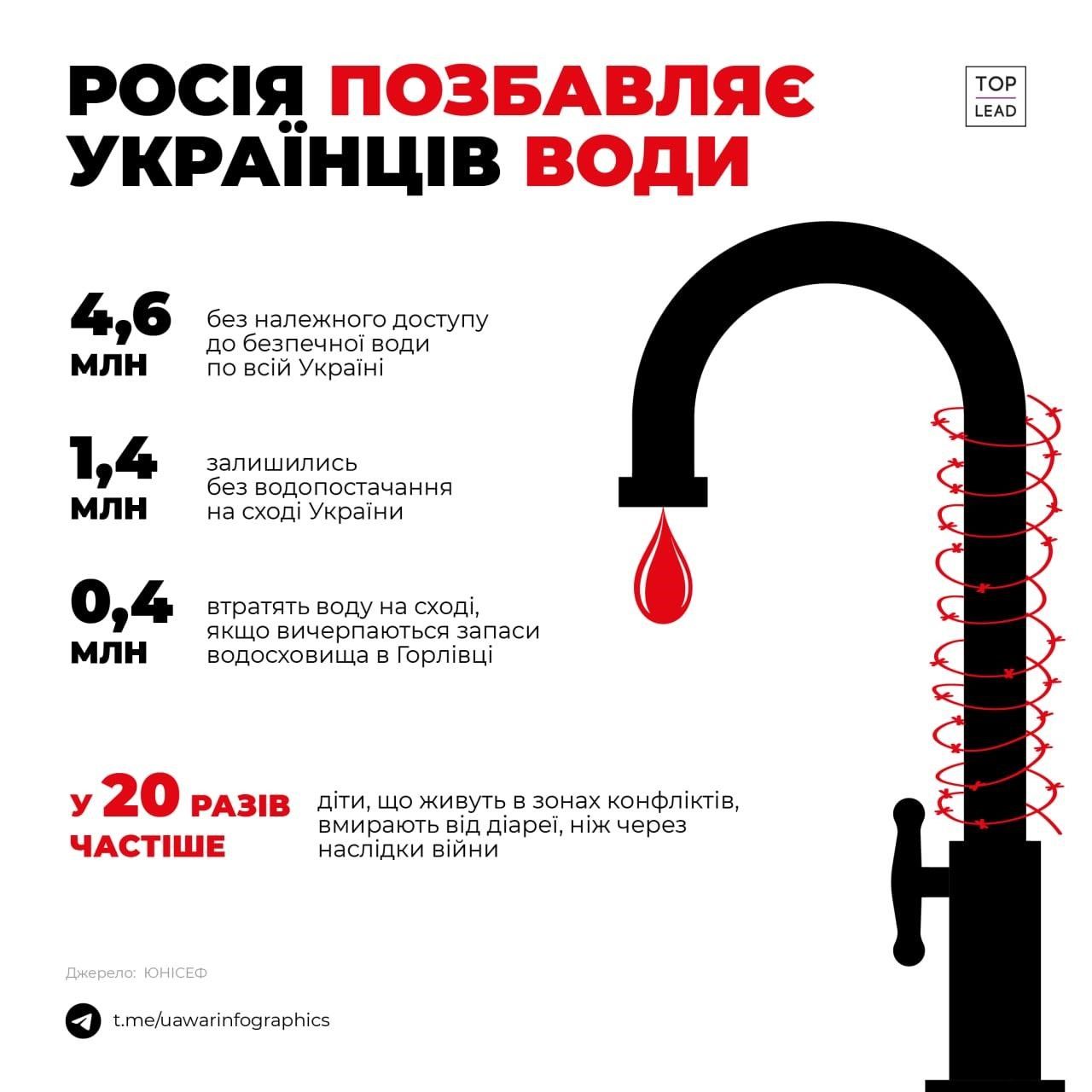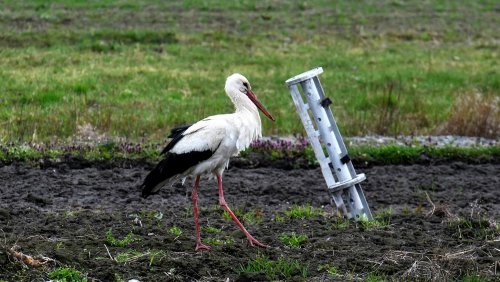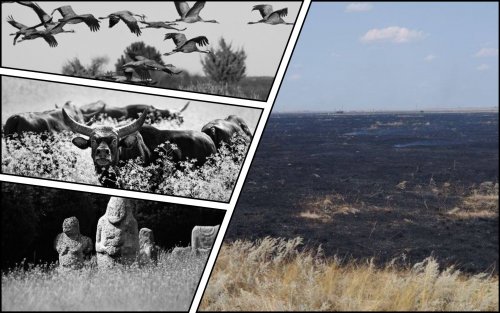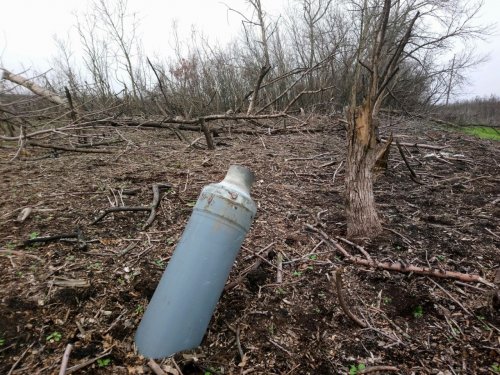More than three months have passed since the start of a large-scale Russian invasion of Ukraine. The operational headquarters of the State Ecological Inspectorate of Ukraine continues to record numerous crimes of the aggressor against the environment and calculates losses.
What environmental crimes against the environment of Ukraine, committed by Russian armed groups, were recorded in May - read on the site EcoPolitics.
Attacks on infrastructure and industrial facilities
On May 1, a Russian missile attack led to a fire at an agricultural enterprise in the Synelnykivskyi district of the Dnipropetrovsk region.
On May 1 in the east of Nikolaevshchina because of attack from the Russian troops the fire on storage of mineral fertilizers (nitrate and nitroamofoskoj) broke out.
On May 1, 18 fires broke out in the Kharkiv region as a result of Russian shelling. On the territory of Zolochiv community, ground fuel tanks belonging to one of the agricultural firms caught fire due to the shelling. The area of the fire was about 1,200 square meters. m. In the Kyiv district of Kharkiv as a result of hit by Russian shells burned two warehouses with tires and herbicides.
On May 3, Russian troops launched more than 20 powerful missile strikes, leading to fires at infrastructure facilities in Dnipropetrovsk, Kirovohrad, Lviv, Vinnytsia, Kyiv and Zakarpattia regions.
On May 4, Russian troops launched missile strikes on infrastructure in Dnipro and Kirovohrad Oblast, resulting in fires.
On May 5, the Russian military fired on the railway plant of the Azot plant in Severodonetsk, Luhansk region. This company is the third largest producer of ammonia in Ukraine and one of the largest chemical companies in Europe. Due to the fire, which covered an area of 400 square meters. m., there was a threat of fire in the company's tanks with hazardous substances.
On May 7, four Russian missiles destroyed a furniture shop in Odessa. Due to the presence of paints and varnishes in the production, a strong fire broke out.
On May 8, Russians fired on an oil refinery in Lysychansk, Luhansk Oblast. As a result of the shelling, the plant's production facilities caught fire: a sulfur production plant and a mixing plant. On May 9, a 360-square-meter fire broke out due to repeated shelling of the Lysychansk refinery.
On May 9, the Russians shelled Odessa again, destroying a shopping and entertainment center (the area of the fire was 1,000 square meters) and 3 warehouses (the area of the fire was over 1,200 square meters).
On May 11, military shelling in the Kramatorsk district of Donetsk region damaged a warehouse with ammonium nitrate. The management of the Slovyansk city military administration asked the residents to limit their stay in the open air and close the windows tightly for one day.
On May 12, 12 Russian missiles hit the infrastructure of the city of Kremenchuk. Most of the missiles were aimed at the Kremenchug refinery. The fire, which broke out at the plant, was contained.
On May 16, the Russian military entered a warehouse with ammonium nitrate in the Kharkiv region. The explosion caused a large column of orange smoke. According to information from the local military administration, this explosion does not pose a threat to the population. The amount of damage to the environment will be determined by specialists.
On May 17, Russian troops launched an air strike on the Knauf Ukraine building materials plant in Soledar, Donetsk Oblast. As a result of the shelling, a large-scale fire broke out.
During the week, numerous shellings of the phenolic plant in New York and the Avdiivka Coke Plant in the Donetsk region, as well as the Nitrogen plant in Severodonetsk, Luhansk region, were recorded.
On May 20, Russian troops launched a rocket attack on a fertilizer plant in the Odessa region, sparking a fire. The air smelled of ammonia.
On May 20, a Russian missile hit one of the infrastructure facilities in Mykolayiv. As a result of the shelling, the city began to smell of ammonia. The city authorities said that there was no danger to the health of the residents, as the concentration of the substance in the air is minimal. On the same day, Russian troops launched missile strikes on infrastructure in Kharkiv, Poltava and Zhytomyr oblasts.
On May 21, the Russians launched a missile strike on a construction base in the Nikolaev area. As a result of the attack, a large-scale fire broke out with heavy smoke, in particular, a gas station and construction materials were burning.
On May 25, the Russian occupiers fired three missiles at the city of Kryvyi Rih in the Dnipropetrovsk region, damaging an industrial plant.
During the week, numerous shellings of the Avdiivka Coke Plant in the Donetsk region, as well as the Azot plant in Severodonetsk and the Lysychansk refinery in the Luhansk region, were recorded.
Large-scale fires in infrastructure and industrial facilities are leading to air poisoning especially dangerous substances. Pollutants can be carried by winds over long distances.

Pollution directly caused by hostilities
On May 11, Russian troops used cluster and phosphorus munitions prohibited by international conventions during an attack on the Kryvyi Rih district of the Dnipropetrovsk region. On May 18, the Russians fired phosphorous shells at a school in Avdiivka, Donetsk Oblast.
In addition, the constant destruction of settlements leads to environmental pollution by construction debris and asbestos . The consequences of such pollution for the environment will be felt for years.
Damage to protected areas and protected ecosystems
On May 12, a Russian missile hit a protected part of the island of Khortytsia in Zaporizhia, causing a fire.
In Kharkov, the Russians destroyed the only plant genetic bank in Ukraine . The projectile hit the building of the Institute of Plant Breeding. St. George's, where samples of more than 160,000 varieties of plants from around the world, which were collected for decades, were stored. There are only a few such banks in the world. Many plant species will no longer be recoverable .
Due to the fighting, birds can change their migration routes through Ukraine. Russia is fighting in protected areas of international and European importance and destroys the habitats of rare and endemic species . Due to the fighting, some unique foci of endemic species may simply disappear.
On the night of May 13, 2022, the Russian occupiers fired two missiles at a forest near the village of Ochkine in the Shostka district. As a result, at least 172 trees of mostly coniferous species were destroyed.
These forest lands are in close proximity to the object of the nature reserve fund of national importance - the National Natural Park "Desnyansko-Starogutsky" and is an important component of the ecosystem of the region. According to state inspectors, the total amount of losses is over 8 million hryvnias.
On May 20 the Russian attack caused a fire in the Galitsinovsky forest near Nikolaev. May 20 part of the forest caught fire in Kharkiv region due to the fall of a Russian missile on the territory of Chuguiv forestry.
Localization of fires continues in the forests of the temporarily occupied Kherson region. The fire covered more than 4,000 hectares. Due to hostilities, minefields and occupation, rescuers and foresters are not always able to fully prevent and eliminate fires.
Specialists of the State Coinspection in Luhansk region with the help of modern space technology found large-scale forest fires in the Luhansk region. According to them, the amount of damage to the environment is over 38.3 billion hryvnias. Damaged areas of the nature reserve fund: National Nature Park "Kreminski Lisy", Hydrological Reserve of Local Importance "Kreminski Kaptazhi" and part of the Luhansk Nature Reserve "Trohizbensky Steppe".
The situation with animals in zoos in cities in the war zone remains difficult. In one of the oldest in Ukraine the Nikolaev zoo continues to be almost 4 thousand animals. Almost every night, the zoo is shelled by the Russian military. Eight missiles have already landed on the territory, including cluster bombs banned by international law.
Damage to water resources
Drinking water in Ukraine is one of the targets of the occupiers. Russian troops are currently:
- pollute water by shelling businesses and warehouses near water bodies, leading to leaks of hazardous substances;
- deprive of cleaning, destroying treatment facilities;
- trying to steal, for example, in attempts to supply the Crimea through the North Crimean Canal.
All these actions cause irreparable damage to aquatic ecosystems and affect human life and health.

On May 17, WHO Regional Director for Emergencies Dorit Nitsan said that the destruction of the water supply system in Mariupol could spread infectious diseases, including cholera.
Currently, all cities of Luhansk region in the territory controlled by Ukraine are without water and sewerage. Water supply and sewerage facilities in Donetsk, Zaporizhia, Kharkiv and Mykolayiv oblasts were significantly damaged.
Due to the spontaneous burial of the dead, lack of quality drinking water and medicine, the Russian-occupied city Mariupol is on the verge of an epidemic catastrophe . Due to the critical situation with sewerage and rupture of sewerage networks in the city, there is a threat that sewage will be in the sea and on the streets.
On May 22, as a result of rocket fire in the Pavlograd district of the Dnipropetrovsk region, the rocket hit the Samara River.
Black and Azov Seas
Russian troops are attacking infrastructure along the Black and Azov coasts and ships at anchor, polluting water and spreading toxins into the sea. In particular, on May 2, the Russian occupiers fired the third missile at the bridge across the Dniester estuary in the Gulf of Odesa.
According to the staff of the National Nature Park "Tuzla Estuaries" due to the actions of Russian warships off the coast of Odessa are recorded facts of dolphin death. Military sonar has a negative impact on animal health. Russian warships use sonar with sounds above 200 decibels. Dolphins fall into the area of radiation of ship navigation devices. This leads to damage to their hearing and disorientation. Under natural conditions, dolphins use echo signals to determine what lies ahead. Having lost orientation, dolphins in a panic can be thrown ashore and perish. The extent of dolphin deaths has not yet been investigated due to the blocking of shipping by the Russian fleet, mining of waters and areas of the Black Sea coast.
On May 14, two enemy sea mines were found in Odesa Oblast, which were brought to the surface by stormy weather and brought closer to shore on one of the beaches. It is estimated that Russian troops have placed 400 to 600 mines in the Black Sea, threatening both shipping and marine life.
Turkish marine biologists report that more than 100 dolphins have been found and dumped on the Black Sea coast since February. This figure is much higher than in previous years.
Note that on Thursday, June 2, there will be an expert online discussion "Reparations for Ukraine: mechanisms, practice, environment".





